In the world of gardening, cultivating a bountiful vegetable harvest is a rewarding endeavor that requires a combination of knowledge, dedication, and a touch of green-thumb magic. Whether you’re a seasoned gardener or a novice with a newfound passion for growing your own produce, there are several key tips to consider to ensure the success of your vegetable garden.

1. Soil Health: The Foundation of a Flourishing Garden
The foundation of any successful vegetable garden lies beneath the surface—healthy soil. Invest time in understanding your soil type and composition. Most vegetables thrive in well-draining soil enriched with organic matter. Compost, aged manure, and other organic amendments can work wonders in improving soil fertility. Regularly testing the pH level of your soil will help you make informed decisions about necessary amendments, ensuring optimal nutrient absorption for your plants.
2. Smart Plant Selection: Tailoring Choices to Your Climate
Different vegetables have unique requirements, and selecting the right varieties for your climate is crucial. Consider the average temperature, sunlight hours, and frost dates in your region. Cool-season crops like lettuce and spinach flourish in spring and fall, while warm-season crops such as tomatoes and peppers require higher temperatures to thrive. Utilize local gardening resources, speak with experienced gardeners, and explore regional plant recommendations to make informed choices that align with your climate.
3. Sunlight: Nature’s Energy Source
Sunlight is the engine that drives the photosynthesis process, providing plants with the energy they need to grow. Most vegetables require at least 6 to 8 hours of direct sunlight daily. When planning your garden layout, take into account the sun’s movement throughout the day and position your vegetable beds accordingly. Adequate sunlight not only promotes robust growth but also contributes to better fruiting and higher yields.
4. Watering Wisdom: Consistency is Key
Consistent and adequate watering is vital for a flourishing vegetable garden. Establish a regular watering schedule, preferably in the morning, to allow plants to absorb moisture before the heat of the day. Be mindful not to overwater, as this can lead to root rot and other water-related issues. Invest in a soaker hose or drip irrigation system to deliver water directly to the base of plants, minimizing water waste and promoting healthier root systems.
5. Spacing and Companion Planting: Strategic Arrangements
Proper spacing between plants is often overlooked but plays a pivotal role in maximizing airflow, minimizing disease, and optimizing sunlight exposure. Follow recommended spacing guidelines for each vegetable variety to prevent overcrowding. Additionally, explore the benefits of companion planting, where certain plants complement each other, either by deterring pests or enhancing nutrient uptake. For example, planting basil alongside tomatoes can help repel certain pests while enhancing the flavor of the tomatoes.
6. Mulching Magic: A Garden’s Protective Blanket
Mulching is a simple yet powerful technique that offers a myriad of benefits to your vegetable garden. A layer of organic mulch, such as straw or wood chips, helps regulate soil temperature, retain moisture, and suppress weed growth. Mulching also acts as a protective barrier, preventing soil-borne diseases from splashing onto plants during rain or watering. Regularly replenish mulch to maintain its effectiveness throughout the growing season.
7. Pest Management: Nature’s Balancing Act
Pests are an inevitable part of gardening, but effective pest management is essential to safeguard your vegetable crops. Embrace natural solutions such as companion planting, where certain plants repel pests or attract beneficial insects. Regularly inspect your plants for signs of pests, and intervene promptly with organic remedies like neem oil, insecticidal soaps, or introducing beneficial insects. Maintaining a healthy balance between pests and natural predators contributes to a thriving, resilient ecosystem in your garden.
8. Regular Maintenance: A Gardener’s Tender Loving Care
A successful vegetable garden requires ongoing attention and care. Regularly inspect plants for signs of disease, nutrient deficiencies, or any other issues. Prune and stake plants as needed to promote proper airflow and support heavy fruit loads. Remove weeds promptly to prevent competition for nutrients and reduce hiding places for pests. By staying proactive and addressing issues as they arise, you’ll ensure the long-term health and productivity of your vegetable garden.
Conclusion: A Journey of Growth and Abundance
Embarking on the journey of growing your own vegetables is a fulfilling and educational experience. With careful consideration of soil health, plant selection, sunlight, watering practices, spacing, mulching, pest management, and regular maintenance, you’ll be well on your way to cultivating a thriving vegetable garden. The rewards extend beyond the harvest, encompassing the joy of nurturing life from seed to table and fostering a deeper connection with the natural world. So, roll up your sleeves, embrace the lessons of each growing season, and revel in the abundance that a well-tended vegetable garden can bring to your home and plate.






